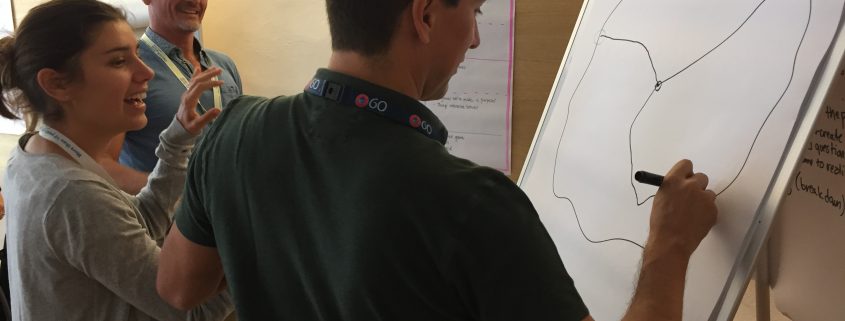Using Serious Games: Seven Tips for New Game Administrators
We just completed our Bright Green Learning Academy training course on “Using Interactive, Experiential Learning Games in Meetings to Communicate Messages (and have fun!)” and part of our course includes selecting, adapting or making a new game and running it for the group – going through the stages of game administration:
- Preparation (parameters, people, space, materials, set up, practice and testing)
- Framing (why are we playing this game?)
- Briefing (instructions, objectives, “rules”, safety)
- Play (observation of dynamics, “rules” enforcement, role of participant observer, etc.)
- Debriefing (what’s the point? Good questions to connect game experience to reality and action, discussion to co-create meaning. )
- Deconstructing (break down)
It was wonderful to see the participants take on new games, work them up and then deliver them for the first time in the course. We know there is the Power of 10 when it comes to creating and mastering games (e.g. you need to play a game 10 times before it is bullet-proof, tweaking all the way), so there was a good opportunity during the games demonstration to generate tips for game administrators. Here are a few that I came up with:
- Watch safety considerations, particularly in games where people are moving around (safety includes both watching chairs and cables and other obstacles in the room if you are inside, curb and pedestrians if outside, but also the physical abilities of participants. For the latter, create roles for people who might prefer to be participant observers – what should they watch out for to report back in the debriefing?)
- Write down the “Rules” or instructions if they are at all complicated. If there are only 2 rules or no rules, then don’t bother (you can repeat them as needed), but if there are a number of rules or parameters to your game, put them on a flip chart and keep that in the room. If you are using this game for the first time, or times, this will also keep you tight and to the point in your briefing.
- Master the space when giving instructions and briefing – this is more of a feeling of confidence that game administrators need to give (remember participants have never played this game and in some cases might have some anxiety about what will happen and what to do). This includes using an instructive tone (think manager talking to construction crew), accuracy and word choice, clarity of speech. Go for crisp and clear instructions so that there is no doubt about how to start, which can inhibit the early stages of the game. If instructions about how to play are a little woolly it can allow for widely different interpretations of the instructions. It is important to remember that, in some games, just ONE word out-of-place can affect the whole outcome of the game.
- Practice until you get your instructions to the point where you don’t get blank looks and that ONE word doesn’t creep in.
- Watch your framing. If you are playing in discovery mode (that is, where people don’t know what to do to “win” the game, but are playing it for the first time), you might not want to give too much framing except to say that the game will help us experience something important that we are or will be discussing. If you are playing in confirmation mode (where people do know the right behaviour and are practicing that), then you can be more explicit with the framing.
- Don’t let participants analyse too much the game at the onset – there is a temptation for the game administrator to ask for questions after the briefing. In some cases this will open the floodgates of questions, analysis of this and that, exploration of options, check this and that, and before you know it the timing is up and you haven’t played. If there is a technical question that is fine, but encourage participants to start and try more or less right away after your good, clear and concise briefing, as most of the time this is where the learning will happen. It’s better if they experience the dynamics of the game, rather than discussing it forever first.
- Let the participants contribute to the debriefing. As eager as you may be to share the “punch line” for the game, use a good questioning sequence to let participants identify what happened, why, how it manifests in real life, and what to do about it. You can perhaps repeat and reinforce the key points at the end, but don’t lead with that.
Games provide a wonderful moment for participants and teams to break out of the usual context of workshops or training, to use their brains, bodies and senses in different ways, and can be powerful learning experiences when they are administered in an equally powerful way!
(our next Games workshop in the Bright Green Learning Academy schedule is in autumn 2017, join us to learn more about using learning games meaningfully in your workshops and meetings!)








Leave a Reply
Want to join the discussion?Feel free to contribute!